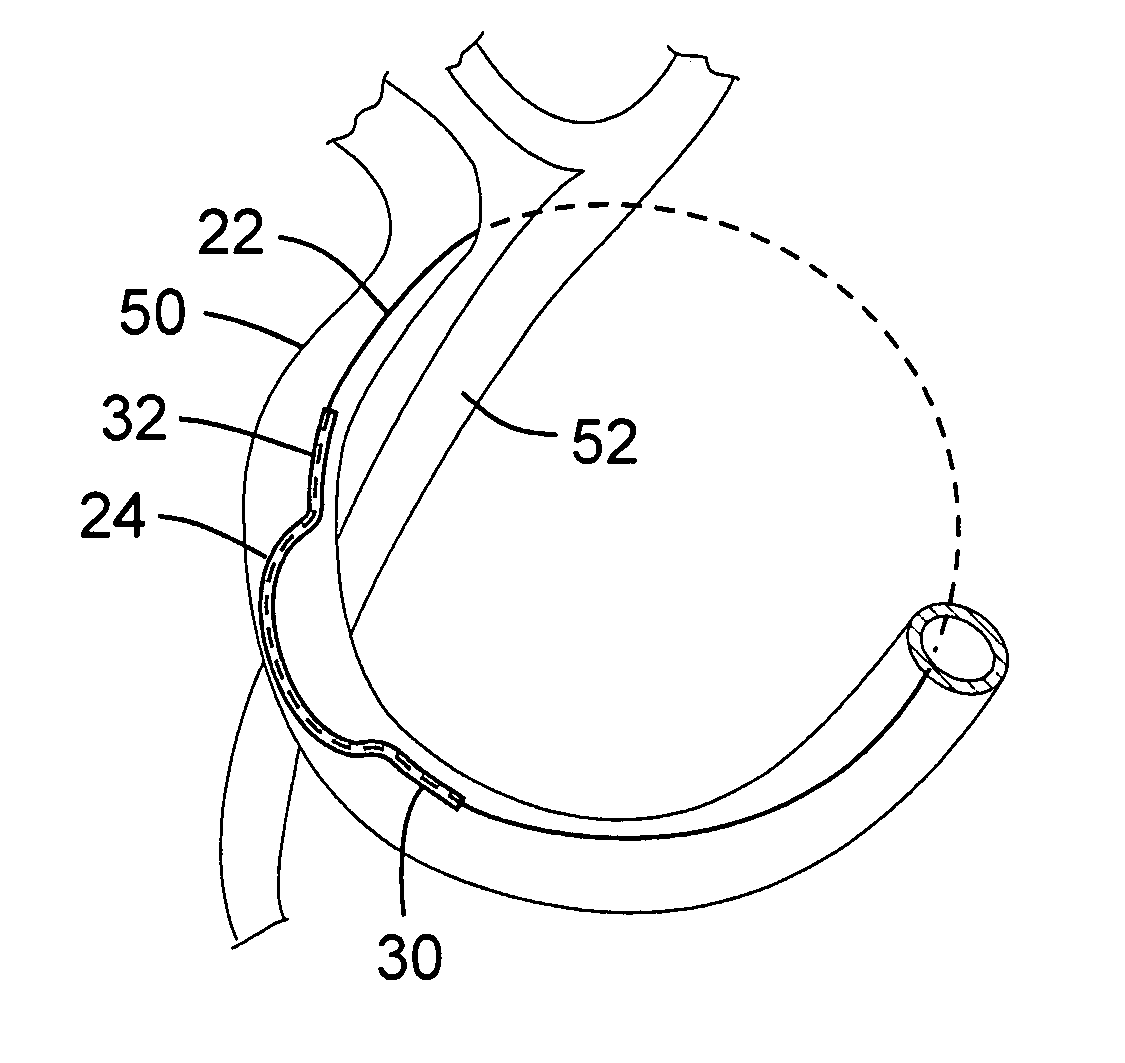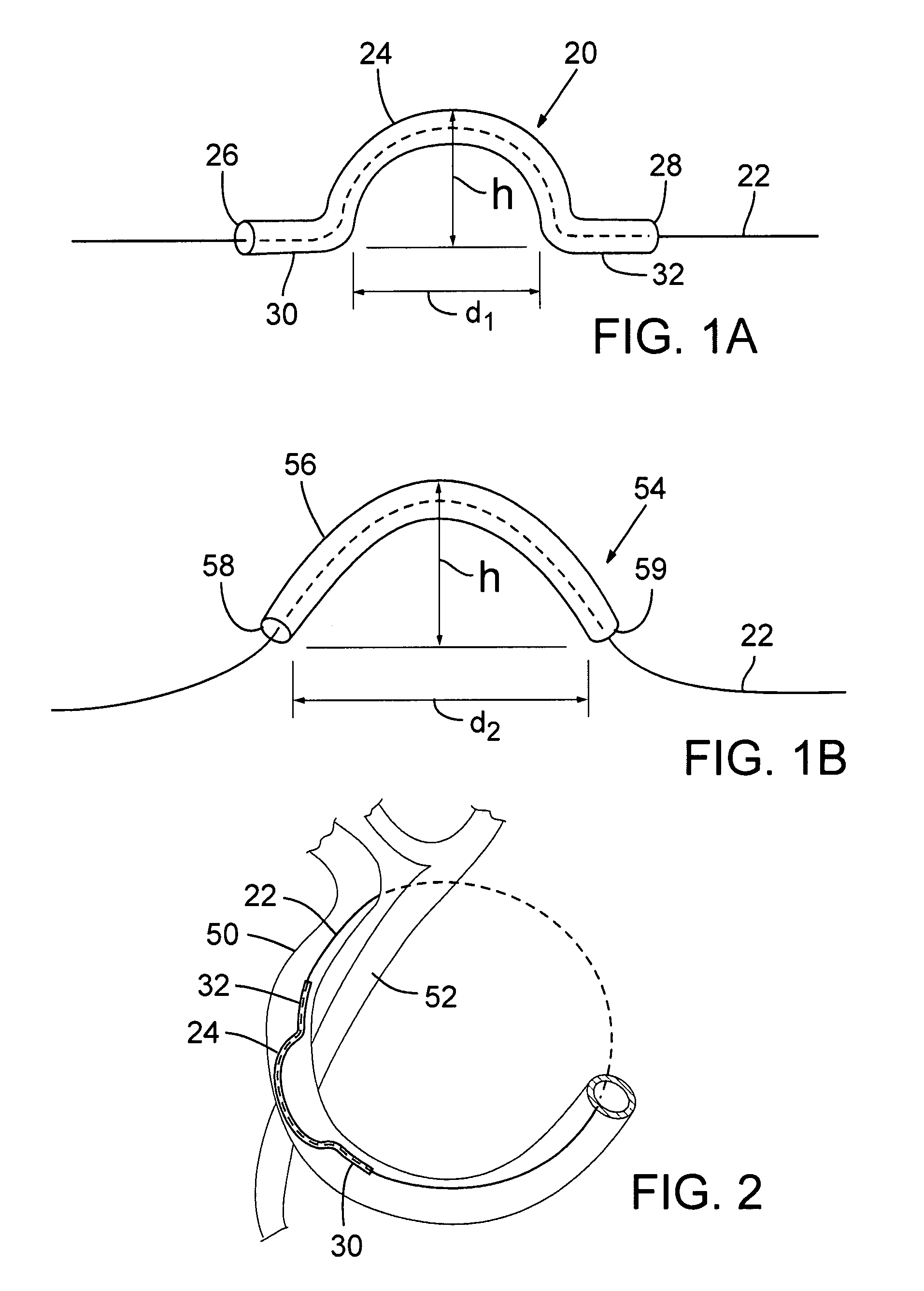Transcatheter coronary sinus mitral valve annuloplasty procedure and coronary artery and myocardial protection device
a technology of mitral valve and annuloplasty procedure, which is applied in the field of annuloplasty, can solve the problems of limiting drawbacks of the trans-sinus approach, affecting the usefulness of the coronary sinus annuloplasty, and affecting the function of the coronary sinus valve, so as to reduce unwanted effects and alter the shape of the heart or valv
- Summary
- Abstract
- Description
- Claims
- Application Information
AI Technical Summary
Benefits of technology
Problems solved by technology
Method used
Image
Examples
example 1
Annuloplasty using Protective Device with Percutaneous Transluminal Coronary Angioplasty Wire for Cerclage
[0078]This Example demonstrates the efficacy of one embodiment of the protective device in protecting the coronary artery from compression during trans-sinus annuloplasty. In this Example, the protective device was constructed of a stainless-steel hypotube (FIG. 5). A 57 kg Yucatan pig was anesthetized, and after obtaining vascular access in the right jugular vein, the femoral vein, and the femoral artery, an annuloplasty wire (0.014 conventional percutaneous transluminal coronary angioplasty (PTCA) wire) was positioned around the mitral annulus to form a cerclage using the method described herein in which tensioning material passes through the coronary sinus over a coronary artery. FIG. 6 shows the left coronary angiogram of the subject with the wire in position, but before tension was applied.
[0079]After encircling the mitral annulus with the annuloplasty wire via the coronary...
example 2
Annuloplasty using an Alternate Embodiment of the Protective Device
[0081]To quantify the protective ability of the device, the pressure in the left circumflex artery was measured using a conventional coronary pressure wire (Radi pressure wire). A 65 kg Yucatan pig was anesthetized, and after obtaining vascular access in the right jugular vein, the femoral vein, and the femoral artery, an annuloplasty wire (0.014 conventional PTCA wire) was positioned around the mitral annulus to form a cerclage essentially as described in Example 1. After placing the cerclage, but before tension was applied, the pressure wire was positioned at a site in the left circumflex artery that was distal to the point where the cerclage passed over the coronary artery. Distal coronary pressure was measured while tension was applied with and without the protective device in place over the left circumflex artery branch. The protective device ameliorated the reduction in distal coronary artery pressure caused by...
example 3
Annuloplasty using a Third Embodiment of the Protective Device
[0082]This Example demonstrates the efficacy of another alternate embodiment of the protective device. For this Example, the protective device was modified to augment the height of the central curve, and thereby further protect the coronary artery from compression during annuloplasty. A 74 kg Yucatan pig was anesthetized, and after obtaining vascular access in the right jugular vein, the femoral vein, and the femoral artery, an annuloplasty wire (0.014 conventional PTCA wire) was positioned around the mitral annulus to form a cerclage essentially as described in Example 1. After placing the cerclage, the end of cerclage wire from the right jugular vein was fixed and graded tensions of 0 grams, 200 grams, 400 grams and 600 grams were applied through the femoral end of a cerclage wire with and without the protective device in position over the left circumflex artery branch. FIG. 9 is a series of angiograms that show the eff...
PUM
 Login to View More
Login to View More Abstract
Description
Claims
Application Information
 Login to View More
Login to View More - R&D
- Intellectual Property
- Life Sciences
- Materials
- Tech Scout
- Unparalleled Data Quality
- Higher Quality Content
- 60% Fewer Hallucinations
Browse by: Latest US Patents, China's latest patents, Technical Efficacy Thesaurus, Application Domain, Technology Topic, Popular Technical Reports.
© 2025 PatSnap. All rights reserved.Legal|Privacy policy|Modern Slavery Act Transparency Statement|Sitemap|About US| Contact US: help@patsnap.com



